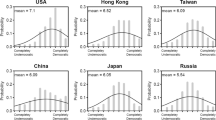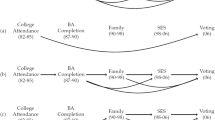Abstract
Many researchers blame voter registration requirements for inequalities in turnout rates across various groups in U.S. society. The number of states with election-day registration (EDR) of voters doubled between the 1990 and 1994 elections, providing a unique opportunity to examine its impact on turnout inequality across demographic groups. The adoption of EDR is found to be associated with large and significant improvements in the turnout rates of young persons relative to older persons, and of recent movers relative to nonmovers. Turnout inequality by income class also declines with EDR adoption, but not by a significant amount in multivariate tests. The adoption of EDR does not improve equality of representation across educational levels.
Similar content being viewed by others
REFERENCES
Avey, Michael J. (1989). The Demobilization of the American Voter: A Comprehensive Theory of Voter Turnout. New York: Greenwood.
Calvert, Jerry W. and Gilchrist, Jack (1993). Suppose they held an election and almost everybody came! PS: Political Science and Politics 26(1): 695–700.
Fenster, Mark J. (1994). The impact of allowing day of registration voting on turnout in U.S. elections from 1960 to 1992. American Politics Quarterly 22(1): 74–87.
Harris, Joseph (1929). Registration of Voters in the United States. Washington, DC: Brookings.
Highton, Benjamin (1997). Easy registration and voter turnout. Journal of Politics 59(2): 565–575.
Highton, Benjamin and Wolfinger, Raymond (1998). Estimating the effects of the National Voter Registration Act of 1993. Political Behavior 20(2): 79–104.
Hill, Kim Quaile and Leighley, Jan E. (1992). The policy consequences of class bias in state electorates. American Journal of Political Science 36(2): 351–365.
Jackson, Robert A., Brown, Robert D. and Gerald C. Wright (1998). Registration, turnout, and the electoral representativeness of U.S. state electorates. American Politics Quarterly 26(3): 259–287.
Kleppner, Paul (1982). Who Voted? New York: Praeger. Knack, Stephen (forthcoming). Election-day registration: The second wave. American Politics Quarterly.
Knack, Stephen (1995). Does motor voter work? Journal of Politics 57(3): 796–811.
Knack, Stephen and White, James (1998). Did states’ motor voter programs help the democrats? American Politics Quarterly 26(3): 344–365.
Leighley, Jan and Nagler, Jonathan (1992). Socioeconomic class bias in turnout, 1964–1988: The voters remain the same. American Political Science Review 86(3): 725–735.
Lijphart, Arend (1997). Unequal participation: Democracy's unresolved dilemma. American Political Science Review 91(1): 1–14.
Mitchell, Glenn E. and Wlezian, Christopher (1995). The impact of legal constraints on voter registration, turnout, and the composition of the American electorate. Political Behavior 17(2): 179–202.
Nagler, Jonathan (1994). Scobit: An alternative estimator to logit and tobit. American Journal of Political Science 38(1): 230–255.
Nagler, Jonathan (1991). The effect of registration laws and education on U.S. voter turnout. American Political Science Review 85(4): 1393–1406.
Piven, Frances Fox and Cloward, Richard A. (1989). Government statistics and conflicting explanations of nonvoting. PS: Political Science and Politics 22(3): 580–588.
Piven, Frances Fox and Cloward, Richard A. (1988). Why Americans Don't Vote. New York: Pantheon.
Powell, G. Bingham, Jr. (1986). American voter turnout in comparative perspective. American Political Science Review 80(1): 17–43.
Rhine, Staci (1995). Registration reform and turnout change in the American states. American Politics Quarterly 23(4): 409–426.
Squire, Peverill, Wolfinger, Raymond E. and Glass, David P. (1987). Residential mobility and voter turnout. American Political Science Review 81(1): 45–65.
Teixeira, Ruy A. (1992). The Disappearing American Voter. Washington, DC: The Brookings Institution.
White, Hal (1980). A heteroskedasticity-consistent covariance matrix estimator and a direct test for heteroskedasticity. Econometrica 48: 817–838.
Wolfinger, Raymond E. and Rosenstone, Steven J. (1980). Who Votes? New Haven: Yale University Press.
Author information
Authors and Affiliations
Rights and permissions
About this article
Cite this article
Knack, S., White, J. Election-Day Registration and Turnout Inequality. Political Behavior 22, 29–44 (2000). https://doi.org/10.1023/A:1006638400784
Issue Date:
DOI: https://doi.org/10.1023/A:1006638400784




